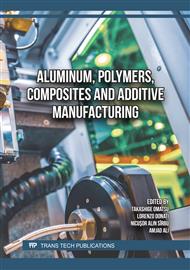[1]
R. Matsunaga et al., "Bidirectional binding property of high glycine-tyrosine keratin-associated protein contributes to the mechanical strength and shape of hair," J Struct Biol, vol. 183, no. 3, pp.484-494, Sep 2013.
DOI: 10.1016/j.jsb.2013.06.005
Google Scholar
[2]
Y. Yu, W. Yang, B. Wang, and M. A. Meyers, "Structure and mechanical behavior of human hair," Mater Sci Eng C Mater Biol Appl, vol. 73, pp.152-163, Apr 1 2017.
DOI: 10.1016/j.msec.2016.12.008
Google Scholar
[3]
H. Ali, K. Rohit, and S. Dixit, "Fabrication and Characterization of Eco-Friendly Natural Human Hair Fiber Reinforced Polyester Composite," Journal of Natural Fibers, vol. 20, no. 1, 2023.
DOI: 10.1080/15440478.2023.2181268
Google Scholar
[4]
R. A. Kurien, M. Maria Anil, S. L. Sharan Mohan, and J. Anna Thomas, "Natural fiber composites as sustainable resources for emerging applications- a review," Materials Today: Proceedings, 2023/05/03/ 2023.
DOI: 10.1016/j.matpr.2023.04.363
Google Scholar
[5]
V. Lunetto, M. Galati, L. Settineri, and L. Iuliano, "Sustainability in the manufacturing of composite materials: A literature review and directions for future research," Journal of Manufacturing Processes, vol. 85, pp.858-874, 2023/01/06/ 2023.
DOI: 10.1016/j.jmapro.2022.12.020
Google Scholar
[6]
T. Yaiphuak, S. Wanchat, and N. Chantarapanich, "Feasibility Study of Selecting Soft Components of Body Armor," Key Engineering Materials, vol. 775, pp.32-35, 2018.
DOI: 10.4028/www.scientific.net/KEM.775.32
Google Scholar
[7]
K. Sridevi, "Development of Mathematical Models for Determination of Failure Loads of Glass Epoxy Composite Plates With Two Parallel Holes.pdf," International Journal of Mechanical Engineering and Robotics Research, vol. 3, no. 3, pp.700-705, 2014.
Google Scholar
[8]
A. Bajpai, A. K. Kadiyala, and C. M. Ó Brádaigh, "Introduction to Epoxy/Synthetic Fiber Composites," in Handbook of Epoxy/Fiber Composites, S. Mavinkere Rangappa, J. Parameswaranpillai, S. Siengchin, and S. Thomas Eds. Singapore: Springer Nature Singapore, 2022, pp.3-34.
DOI: 10.1007/978-981-19-3603-6
Google Scholar
[9]
M. Balachandar, B. Vijaya Ramnath, S. Ashok Kumar, and G. Siva Sankar, "Experimental evaluation on Mechanical Properties of Natural Fiber Polymer Composites with Human Hair," Materials Today: Proceedings, vol. 16, pp.1304-1311, 2019.
DOI: 10.1016/j.matpr.2019.05.228
Google Scholar
[10]
D. M. K. Manik, R. H. Gajghat*, and A. Joseph, "Mechanical Properties of Epoxy Resin Matrix Composites Reinforced with Jute Fiber, Coconut Coir and Human Hair," International Journal of Engineering and Advanced Technology, vol. 9, no. 1, pp.1270-1275, 2019.
DOI: 10.35940/ijeat.A9631.109119
Google Scholar
[11]
S. V. Vatsal, "Fabrication and Analysis of Human Hair Based Hybrid Epoxy Composite for Mechanical Properties," International Journal of Innovative Science and Research Technology, vol. 07, no. IJISRT, pp.459-465, 2017 2017.
Google Scholar
[12]
B. R. Vijay and A. S. Srikantappa, "Physico-Mechanical and Tribological Properties of Glass Fiber Based Epoxy Composites," International Journal of Mechanical Engineering and Robotics Research, pp.929-934, 2019.
DOI: 10.18178/ijmerr.8.6.929-934
Google Scholar
[13]
ASTM D638-02, "Standard Test Method for Tensile Properties of Plastics," American Society for Testing and Materials, West Conshohocken, PA, 2002.
Google Scholar
[14]
Y. Liu, L. Wang, K. Cao, L. Sun, and J. Aguiar, "Review on the Durability of Polypropylene Fibre-Reinforced Concrete," Advances in Civil Engineering, vol. 2021, pp.1-13, 2021.
DOI: 10.1155/2021/6652077
Google Scholar



